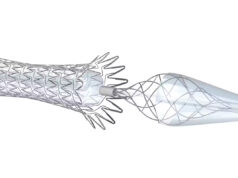In past years the Crawford Critical Issues Symposium has served as a forum in which nonclinical issues took center stage. At the 2016 Vascular Annual Meeting, Dr. Ron Fairman of the University of Pennsylvania Health System will take the symposium in a clinical direction with an issue that, he says, highlights critical questions about appropriateness of care. Titled “In Search of Clarity,” speakers will talk about interventions for claudication in the superficial femoral-popliteal arteries. This year’s lineup will address the role of medical management and exercise, along with the choice, cost, and durability of common interventions.
Speakers will be:

Courtesy University of Pennsylvania
Dr. Ron Fairman
Dr. Mary McDermott of Northwestern University, on exercise;
Dr. Elizabeth Ratchford, Johns Hopkins University on medical management;
Dr. Michael Conte, of the University of California San Francisco, on understanding data sets, durability, and guidelines;
Dr. Peter Schneider of Kaiser Permanente on how claudication is approached in a system outside the traditional fee-for-service model;
Dr. Dennis Gable of Texas Vascular Associates on approaches to claudication in the community practice setting; and
Dr. Robert Zwolak of Dartmouth-Hitchcock Medical Center on the financial aspects, including hidden costs.
VC: Why did you choose claudication as this year’s key theme?
Dr. Fairman: There is probably no other subject that touches more on appropriateness of care than interventions for claudication, and if you look at how patients are managed across the country, there probably is no greater area of disparity. One of the most significant aspects of treating patients with expensive interventions for claudication is frequently the lack of durability. We often see patients in the office who present for a second opinion who already have undergone multiple invasive interventions over a 1- to 2-year period, all resulting in short-term improvement followed by – frighteningly – a much more serious set of symptoms than they started with. And this is fostered by a reimbursement system that demonstrates a willingness to reimburse physicians and hospitals for procedures that have little durability.
VC: Is there too much of a leap in the vascular community to invasive interventions?
Dr. Fairman: I believe that the members of our society understand that before a patient is considered for an invasive intervention for claudication, they should undergo exercise training and optimization of their medical status – but there are challenges associated with that. How do you do get a patient connected to a training regimen? Have all the patient’s risk factors been effectively addressed? Have they quit smoking? Is their blood sugar under control? We view ourselves as a unique specialty that offers comprehensive care of patients with vascular disease. We don’t just do surgery and procedures, but we have the ability to offer the entire package. We also understand by virtue of our training the natural history of the anatomic lesions we are treating. It is essential that physicians look at the whole patient before planning an intervention, and this forum should help us think more about that.
VC: What’s missing from a research perspective that might shed light on when intervention is needed and which interventions to perform?
Dr. Fairman: We need studies comparing durability of interventions with longer follow-up; 1 year is not enough. Dr. Conte will address what the available large data sets show in terms of durability. We need real-world data that compare technologies for claudication. We all have biases about technology based on our own experiences, but many of us struggle in selecting from the very many interventional options available to treat our patients. In addition, physician reimbursement typically increases from simple balloon angioplasty, to placement of a stent, to atherectomy.
VC: What other cost and reimbursement issues do you expect to deal with during the symposium?
I’m interested in Dr. Schneider’s perspective practicing in a health system that is a non–fee-for-service model. How does he make day-to-day decisions about using technology? Dr. Zwolek will talk about the financial side, not only in terms of physician reimbursement, but how physicians should view the expensive disposable inventory that they use when treating patients with claudication. This relates to hospital or facility reimbursement and issues related to margin. Regrettably, given the time constraints of this program, we were unable to secure speakers representing the viewpoints and perspectives of CMS [the Centers for Medicare and Medicaid Services] and the FDA [Food and Drug Administration].












